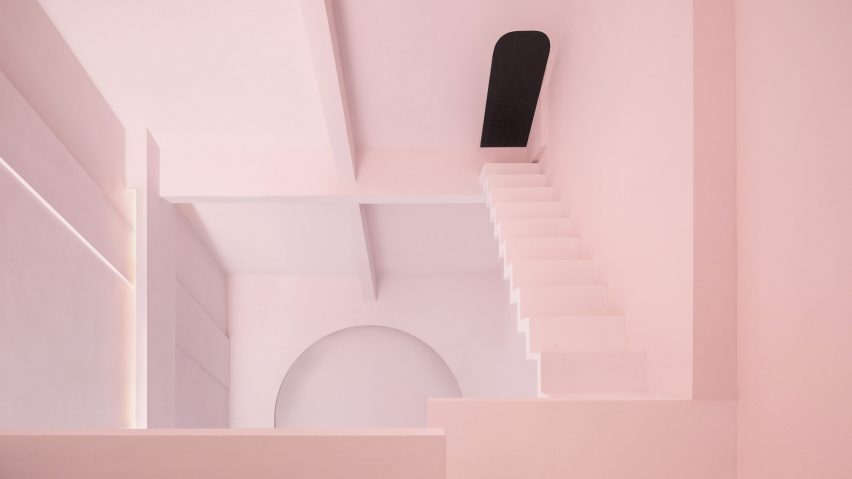Maze-like stairways and optical illusions are designed to trick the eyes of lodgers at this MC Escher-inspired guesthouse in the city of Guilin, China.
Located by the Li River in Guilin, a prefecture city in the northeast of China's Guangxi region, the guesthouse is comprised of differently themed rooms, with two designed by Shenzhen-based Studio 10. These guest rooms are called Dream and Maze.
Guesthouse owner Feifei Yi asked the studio for a creative and otherworldly renovation that would reflect the nature of the hotel as a "hideout from the bustling world", while making the best use of the existing seven-metre-high structure with a pitched roof.
"After visiting the site for the first time, which was just an unfinished, concrete room, we saw the opportunity to do something special, spatially, as the space was unusually high and felt almost like a chapel," said the studio. "Some obscure thoughts started to emerge."
Inspired by the work of Dutch graphic artist Escher – known for his eye-tricking illustrations – the studio set out to create a "mysterious, infinite and impossible space", merging 2D and 3D elements to produce a series of optical illusions.
"The challenge was in keeping the balance between the practical need of a hotel suite and the illusionary, spatial effect we wanted to achieve," the studio told Dezeen.
The two whimsical interiors feature puzzling arched doorways and anti-gravitational staircases, based on Escher's well-known labyrinth-like Relativity lithograph.
In the Dream rooms, a colour palette of pale pink and white creates a "serene" and "fresh" environment, in a bid to distance the spaces from "the chaos of mundane daily life".
According to the studio, this pink palette also resembles cotton candy and marshmallows – colours that they associate with "sweet dreams", playfully hinting towards the bedroom setting.
Any components indicative of the real world, such as light fixtures and electronic appliances, have been concealed behind a series of fake doors painted in black, maintaining the immaculate and whimsical nature of the interior.
The Maze rooms on the other hand boast hues of gold and forest green, intended to emulate a fairy-tale-like "secret forest" with hidden doors that lead to unknown things.
Both colour palettes aim to reflect the idea of a utopia or an alternate world, inspired by the name of the guesthouse, The Other Place. The studio wanted to differentiate the rooms from the spaces we encounter in everyday life.
Also inspired by Escher's optical illusions, Japanese studio Nendo opened an exhibition of the illustrator's work at the National Gallery of Victoria in Melbourne in December 2018.
The exhibition, called Between Two Worlds, displays 157 prints and drawings by Escher within an immersive monochrome setting that draws on the artist's work by playing with themes of geometry and space.
Photography is by Chao Zhang.

